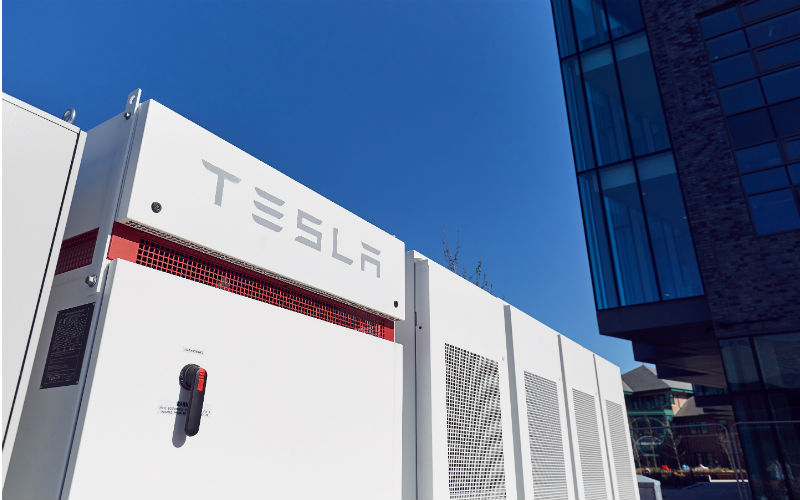

Energy
Tesla Powerpacks selected as backup system for UK park operator’s HQ
Tesla’s Powerpacks have been selected as the backup system of choice for Manchester Science Partnerships (MSP), one of the UK’s most prominent science and technology park operators. The big battery is part of the MSP’s ongoing initiative to employ and utilize advanced energy solutions.
The Tesla Powerpack system would be installed outside the MSP’s flagship headquarters, located at the Bright Building in Manchester Science Park. Apart from the Powerpacks, MSP will also be building two charging points for electric vehicles on its HQ’s premises.

The Bright Building in the UK, housing the MSP’s flagship HQ. [Credit: Manchester Science Partnerships]
According to a press release, the installation of the Powerpacks and the construction of the charging stations would help insulate the MSP from changing commercial tariffs and surging non-commodity prices. More importantly, however, the adoption of green technologies would significantly reduce the carbon footprint of the park operator’s headquarters.
Perhaps the most notable advantage of the Tesla Powerpack system for the MSP, however, would be the big battery’s capability to respond quickly in the event of a power shortage. As could be seen in the performance of the South Australia Powerpack farm near Jamestown, the system could respond to outages in less than a second — far quicker than traditional backup energy solutions like diesel generators.
The Tesla Powerpack batteries are also scalable, which would enable MSP to install additional batteries if its headquarters’ power needs increase. With enough Powerpack batteries, the park operator’s HQ in Bright Building could eventually run all day on its energy storage system alone.
MSP managing director Tom Renn stated that the company is excited about the idea of using Tesla’s Powerpacks as the headquarters’ backup power system.
“As the only UK science and technology park operator to be offering this kind of advanced energy innovation, it’s something we’re understandably very excited about. This pilot installation marks a key milestone in our advanced energy strategy. It also makes good on a commitment to invest in sustainable improvements to our campuses, signed up to as part of our green funding package with Lloyds Bank.
“We have bold plans to harness the opportunities provided by advanced energy. We envisage that within 12 months, the Bright Building will be an energy island – self-sufficient and operating without reliance on the National Grid.”
Tesla’s Powerpacks have so far proven their worth across the globe. Just recently, Tesla CEO Elon Musk responded to an islandwide blackout in Puerto Rico by pledging to expand the country’s existing solar and battery solutions 24/7 to support the country’s ravaged energy grid better. Since being hit by Hurricane Maria last year, Puerto Rico has been embroiled in a power crisis, and Tesla has been doing its part helping the island nation through its products such as the Powerpack, Powerwall home battery, and solar panels.
In South Australia, Tesla’s Powerpack farm, dubbed as the world’s biggest lithium-ion battery, continues to support the region’s power grid. The Powerpacks have proven to be so efficient; Tesla is reportedly not getting paid properly anymore since the big battery responds too fast for the Australian Energy Market Operator’s legacy billing system.

Cybertruck
Tesla updates Cybertruck owners about key Powershare feature

Tesla is updating Cybertruck owners on its timeline of a massive feature that has yet to ship: Powershare with Powerwall.
Powershare is a bidirectional charging feature exclusive to Cybertruck, which allows the vehicle’s battery to act as a portable power source for homes, appliances, tools, other EVs, and more. It was announced in late 2023 as part of Tesla’s push into vehicle-to-everything energy sharing, and acting as a giant portable charger is the main advantage, as it can provide backup power during outages.
Cybertruck’s Powershare system supports both vehicle-to-load (V2L) and vehicle-to-home (V2H), making it flexible and well-rounded for a variety of applications.
However, even though the feature was promised with Cybertruck, it has yet to be shipped to vehicles. Tesla communicated with owners through email recently regarding Powershare with Powerwall, which essentially has the pickup act as an extended battery.
Powerwall discharge would be prioritized before tapping into the truck’s larger pack.
However, Tesla is still working on getting the feature out to owners, an email said:
“We’re writing to let you know that the Powershare with Powerwall feature is still in development and is now scheduled for release in mid-2026.
This new release date gives us additional time to design and test this feature, ensuring its ability to communicate and optimize energy sharing between your vehicle and many configurations and generations of Powerwall. We are also using this time to develop additional Powershare features that will help us continue to accelerate the world’s transition to sustainable energy.”
Owners have expressed some real disappointment in Tesla’s continuous delays in releasing the feature, as it was expected to be released by late 2024, but now has been pushed back several times to mid-2026, according to the email.
Foundation Series Cybertruck buyers paid extra, expecting the feature to be rolled out with their vehicle upon pickup.
Cybertruck’s Lead Engineer, Wes Morrill, even commented on the holdup:
As a Cybertruck owner who also has Powerwall, I empathize with the disappointed comments.
To their credit, the team has delivered powershare functionality to Cybertruck customers who otherwise have no backup with development of the powershare gateway. As well as those with solar…
— Wes (@wmorrill3) December 12, 2025
He said that “it turned out to be much harder than anticipated to make powershare work seamlessly with existing Powerwalls through existing wall connectors. Two grid-forming devices need to negotiate who will form and who will follow, depending on the state of charge of each, and they need to do this without a network and through multiple generations of hardware, and test and validate this process through rigorous certifications to ensure grid safety.”
It’s nice to see the transparency, but it is justified for some Cybertruck owners to feel like they’ve been bait-and-switched.
Energy
Tesla starts hiring efforts for Texas Megafactory
Tesla’s Brookshire site is expected to produce 10,000 Megapacks annually, equal to 40 gigawatt hours of energy storage.

Tesla has officially begun hiring for its new $200 million Megafactory in Brookshire, Texas, a manufacturing hub expected to employ 1,500 people by 2028. The facility, which will build Tesla’s grid-scale Megapack batteries, is part of the company’s growing energy storage footprint.
Tesla’s hiring efforts for the Texas Megafactory are hinted at by the job openings currently active on the company’s Careers website.
Tesla’s Texas Megafactory
Tesla’s Brookshire site is expected to produce 10,000 Megapacks annually, equal to 40 gigawatt hours of energy storage, similar to the Lathrop Megafactory in California. Tesla’s Careers website currently lists over 30 job openings for the site, from engineers, welders, and project managers. Each of the openings is listed for Brookshire, Texas.
The company has leased two buildings in Empire West Business Park, with over $194 million in combined property and equipment investment. Tesla’s agreement with Waller County includes a 60% property tax abatement, contingent on meeting employment benchmarks: 375 jobs by 2026, 750 by 2027, and 1,500 by 2028, as noted in a report from the Houston Business Journal. Tesla is required to employ at least 1,500 workers in the facility through the rest of the 10-year abatement period.
Tesla’s clean energy boom
City officials have stated that Tesla’s arrival marks a turning point for the Texas city, as it highlights a shift from logistics to advanced clean energy manufacturing. Ramiro Bautista from Brookshire’s economic development office, highlighted this in a comment to the Journal.
“(Tesla) has great-paying jobs. Not just that, but the advanced manufacturing (and) clean energy is coming to the area,” he said. “So it’s not just your normal logistics manufacturing. This is advanced manufacturing coming to this area, and this brings a different type of job and investment into the local economy.”
Energy
Tesla and Samsung SDI in talks over new US battery storage deal: report
The update was related by industry sources and initially reported by South Korean news outlets.

Recent reports have suggested that Tesla and Samsung SDI are in talks over a potential partnership to supply batteries for large-scale energy storage systems (ESS).
The update was related by industry sources and initially reported by South Korean news outlets.
ESS batteries to be built at Samsung’s Indiana plant
As noted in a report from Korea JoongAng Daily, the demand for energy storage systems has been growing rapidly in North America, thanks in no small part to the surge in AI investments across numerous companies. With this in mind, Tesla has reportedly approached Samsung SDI about a potential battery supply deal.
The deal is reportedly worth over 3 trillion Korean won (approximately $2.11 billion) and will span three years, according to The Korea Global Economic Daily. A battery supply deal with Samsung SDI could make sense for Tesla as the company already has a grid-scale battery, the Megapack, which is perfect for industrial use. Samsung SDI could simply supply cells for the EV maker.
Production of the batteries would reportedly take place at Samsung SDI’s joint venture factory with Stellantis in Indiana, which is currently under construction. Samsung SDI recently announced plans to use part of that plant’s EV lines to produce cells for ESS, with a targeted capacity of 30 GWh by the end of next year.
Tesla and Samsung’s partnership
At present, only a handful of manufacturers, including Korea’s LG Energy Solution, Samsung SDI, SK On, and Japan’s Panasonic, are capable of producing energy storage-scale batteries domestically in the United States. A Samsung SDI official issued a comment about the matter, stating, “Nothing has been finalized regarding cooperation with Tesla.”
The possible energy storage system deal adds another layer to Tesla’s growing collaboration with Samsung, which is already in line as a partner in the upcoming production of Tesla’s AI5 and AI6 chips. Early sample manufacturing of the AI6 is expected to begin in South Korea, with mass production slated for Samsung’s Texas-based Taylor foundry when it starts operations.
The AI6 chip will power Tesla’s next wave of high-volume projects, including the Optimus humanoid robot and the autonomous Cybercab service. Musk has called the partnership with Samsung a “real collaboration,” adding that he personally plans to “walk the line” at the Taylor facility to speed up progress.








